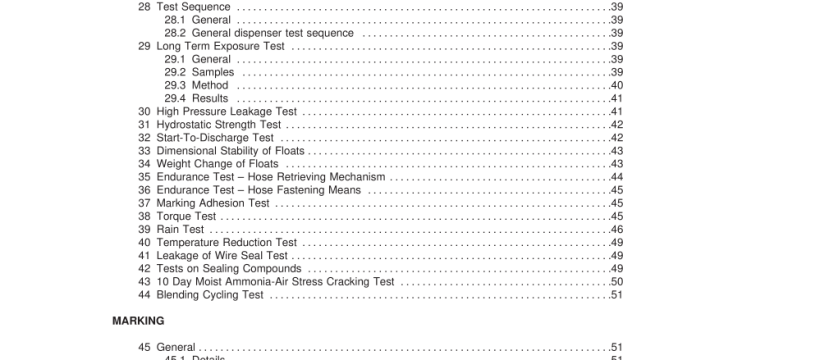UL 87A-2015 pdf download.Power-Operated Dispensing Devices for Gasoline and Gasoline/Ethanol Blends with Nominal Ethanol Concentrations up to 85 Percent (E0 – E85).
2 General 2.1 Components 2.1 .1 Except as indicated in 2.1 .2, a component of a product covered by this outline shall comply with the requirements for that component. 2.1 .2 A component is not required to comply with a specific requirement that: a) Involves a feature or characteristic not required in the application of the component in the product covered by this standard, or b) Is superseded by a requirement in this standard. 2.1 .3 A component shall be used in accordance with its rating established for the intended conditions of use. 2.1 .4 Specific components are incomplete in construction features or restricted in performance capabilities. Such components are intended for use only under limited conditions, such as certain temperatures not exceeding specified limits, and shall be used only under those specific conditions. 2.2 Units of measurement 2.2.1 Values stated without parentheses are the requirement. Values in parentheses are explanatory or approximate information. 2.3 Undated references 2.3.1 Any undated reference to a code or standard appearing in the requirements of this standard shall be interpreted as referring to the latest edition of that code or standard.
3 Glossary 3.1 For the purpose of this standard, the following definitions apply. 3.2 AIR GAP – A minimum of 1 inch (25.4 mm) free air space provided between the planes of Division 1 and Division 2 hazardous locations and an unclassified area of a dispensing device. 3.3 BASE – The part of the assembly that is intended to be secured to the foundation on which the device will be installed. 3.4 BLENDING OPTION – Dispensing devices may be provided with an option that blends two specific fuels into one fuel to be dispensed. This blending occurs at the dispenser level and can be in two forms: a) Fixed blending – Blending at the dispenser level that blends two specific fuels into one fuel to be dispensed, and that fuel to be dispensed is fixed. For example, fixed blending includes blend options where gasoline and denatured fuel ethanol can be blended to achieve E85, which is the actual dispensed fuel.
3.6 DISPENSER, BLENDING – A dispensing device that is provided with a blending option 3.7 DISPENSER, REMOTE CONTROL TYPE – A dispensing device that does not contain a power- operated pump as part of the assembly, and which is intended for connection to a fluid piping system containing the power-operated pumps at a remote location. Also commonly identified as a “dispenser”. 3.8 DISPENSER, SELF-CONTAINED – A dispensing device that includes a power-operated pump as part of the assembly. Also commonly identified as a “pump” or “suction dispenser”. 3.9 DISPENSING DEVICE – A product consisting of various components as applicable, which are used to control and meter the flow of liquid from an upstream storage device. 3.1 0 ELECTRICAL CIRCUITS – a) High Voltage Circuit – A circuit having a potential of not more than 600 volts and having circuit characteristics in excess of those of a low voltage or Class 2 circuit. b) Low Voltage Circuit – A circuit involving a potential of not more than 30 volts ac (rms) (42.4 volts peak or dc) and 1 ) Supplied by a Class 2 transformer, or by a battery, by a battery and fixed impedance, or by a transformer and fixed impedance each of which, as a unit, is in compliance with what is required for a Class 2 transformer, or 2) Limited to a maximum of 1 00 volt-amperes. A circuit derived from a source of supply classified as a high voltage circuit, by connecting resistance in series with the supply circuit as a means of limiting the voltage and current, is not considered to be a low voltage circuit.UL 87A-2015 pdf download.
UL 87A-2015 pdf download
